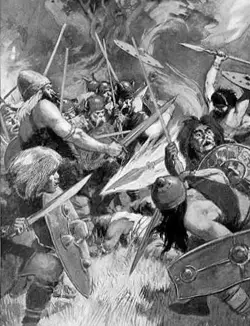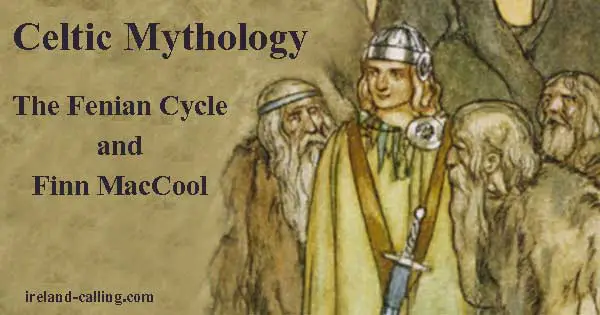The Fenian Cycle is one of a series of four collections of Irish mythological stories – the others being the Ulster Cycle, the Mythological Cycle and the Cycle of Kings.
All the cycles are based on manuscripts produced by Irish monks who between the 11th and 15th centuries wrote down for the first time the myths and legends that previously had been passed down by word of mouth for thousands of years.
The Fenian Cycle of stories relate to the Fianna, the groups of warriors once said to have roamed Ireland in search of adventure and riches.
The main hero of the stories is the legendary Finn MacCool, known as Fion Mac Cumhaill in the Irish language.
Fenian Cycle background
According to legend, the Fianna were warriors from a number of clans brought together by the High King of Ireland, Cormac mac Art. Their purpose was to unite to protect Ireland but that didn’t stop them from developing factions and fighting each other.

This infighting leads to the Battle of Knock, in which Finn’s father is killed and his clan’s treasure bag is stolen.
When Finn grows up he becomes a great warrior and sets out to seek revenge. He kills those responsible for his father’s death, retrieves the treasure bag and becomes the leader of his people, the Clan Bascna.
In another story from the Fenian Cycle, Finn faced the goblin Aillen the Burner who terrorised Ireland by playing music on his harp that rendered the Fianna warriors helpless. Finn used a magic spear, which nullified the effects of the music, to kill the goblin. The king was so grateful he made Finn leader of all the Fianna.
Love elements – Finn and Sadbh
The Fenian Cycle contains a great deal of love and romance as well as fighting.
In one story, Finn catches a fawn while out hunting. To his surprise, his two hounds won’t let him kill it. He brings it home and later that night it turns into a beautiful woman called Sadbh. She had been transformed into a fawn by a curse from the druid Fer Doirich.
The druid’s spell had been broken when Finn brought the fawn to his home fort, Dun Allen. He marries Sadbh and while she remained at Dunn Allen, she was safe from the spell.
The Fenian Cycle is sometimes known as the Ossian Cycle after Oisin, its narrator.
However, one day when Finn was out at battle, the druid Fer Doirich impersonates him and manages to trick Sadbh into leaving the fort. She is immediately transformed back into a fawn. Finn searches for seven years but can’t find her anywhere.
All he finds is a boy who says he’d been raised by a fawn who was taken away by an evil druid. Finn realises the boy is his son and names him Oisin, meaning little fawn. He looks after the boy who grows up to be a great bard and the narrator of the Fenian Cycle.
Diarmuid and Grainne with Finn as villain
Not all the stories in the Fenian Cycle show Finn as the hero; he also has roles as a villain, as in the story of Diarmuid and Grainne.
The High King of Ireland promises the beautiful Grainne to Finn in marriage. But Finn is old by this time and Grainne falls in love with Diarmuid, the young and emerging hero of the Fianna.
The two elope leaving Finn furious. He eventually is reconciled with the young couple but never forgets his humiliation. He invites Diarmuid to go hunting with him. The young man is badly wounded when he is gored by a bore.
Finn has the power to heal the injured young man by allowing him to drink water from his cupped hand. Instead of using this power, however, he allows the water to run through his fingers and the young man dies.
Finn as the legendary Irish giant
Over the centuries the Finn MacCool warrior of legend changed character somewhat as he became the subject of various comical fairy stories.
One of the most famous of these stories is A Legend of Knockmany in which Finn is presented as an Irish giant building the Giant’s Causeway in Antrim. Finn is presented as a figure of fun as he and his wife outwit the fearsome Scottish giant, Cucullin.
